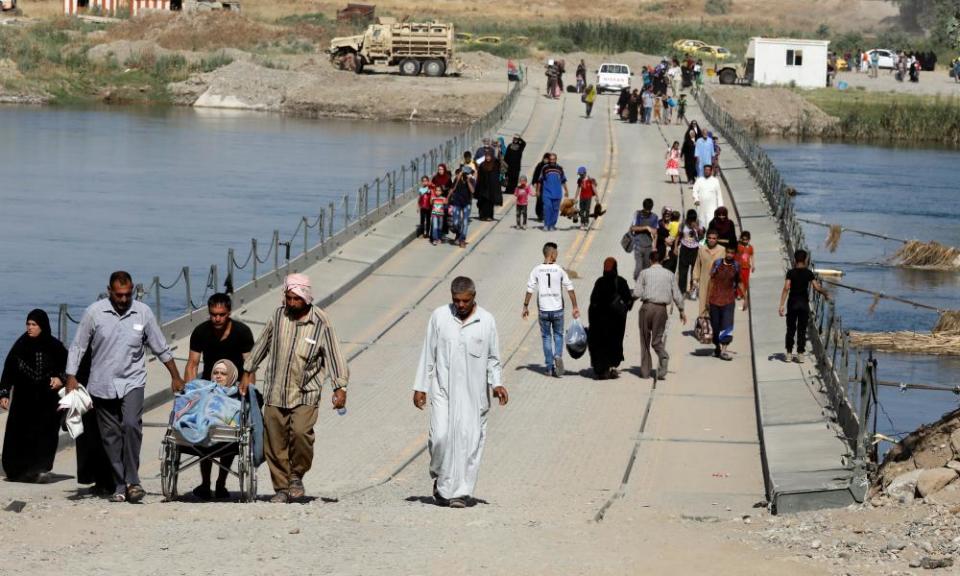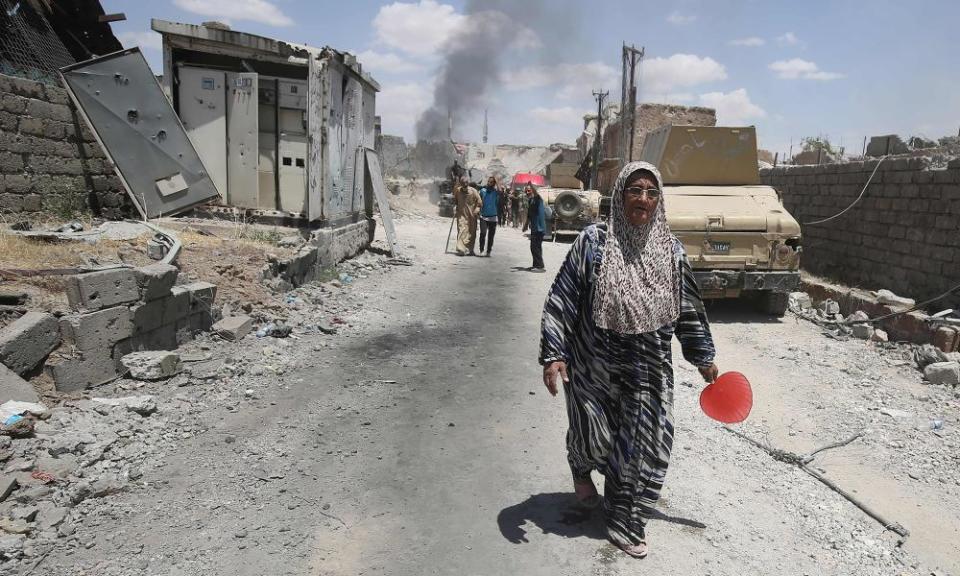Rival groups vie for supremacy as fight against Isis reaches tipping point

Iraqi forces have advanced to the base of the toppled minaret of Mosul’s Great Mosque of al-Nuri, hours after it was destroyed by Islamic State militants, as the bitter eight-month battle to recapture the city reached a tipping point.
The destruction of the mosque marked a pivotal moment in the war against Isis, which declared its now withered caliphate from there three years ago. The terror group’s wanton act of sabotage was widely seen as a harbinger of its imminent defeat.
Across northern Iraq, only a portion of Mosul’s old city and a small adjoining neighbourhood remain under Isis control. The nearby towns of Tel Afar and Hweija, both of which are surrounded, make up the remainder of the group’s territory, a mere sliver of the lands over which it had lorded at the height of its power in mid-2014.
As its fortunes have turned, the group’s remaining members have fled Iraq for the deserts of Syria. So rapid has been their capitulation that plans are now being drafted for a decisive battle later this year, somewhere between the Syrian and Jordanian borders, areas far from those that Isis had coveted.
Lined up in pursuit are a range of players who had have staked claims throughout the fight with Isis, as well as parallel regional conflicts, and have waited for the time to consolidate. As the organisation crumbles, all sides have now started competing for an edge, who gets to define what emerges from the collapse of Isis is a prize bigger than winning the war itself.
Russia, Iran and the US are scrambling for supremacy, eschewing the brinkmanship that has peppered the war for direct clashes unprecedented in the region over recent decades.
As Mosul and Isis’s Syrian epicentre, Raqqa, have started to teeter, Iranian proxies and the US have squared off at least three times on the Syrian side of border. Last week, the risk of further escalation increased when a US jet downed a Syrian plane over the north of the country, drawing a warning from Russia that coalition planes should stay out of its radar range.
Washington said its fighter jet acted to defend its proxies who were moving through Isis-held areas around Raqqa. Raised over the past year to the chagrin of Syria, the anti-Assad opposition, Turkey and increasingly Russia – the mainly Kurdish force has been set the task of retaking Raqqa and nearby towns. As it has edged ahead, Russian and Syrian forces have taken more aggressive postures.
“They are running interference there,” said a senior western official. “They do not want anyone but the Syrian army, which is nearly all Iranian-backed Shia militias, taking that city. As the campaign has changed from talk to reality, they have started to act against it.”
Iran too has taken an unusually direct stance in the multilayered conflict, firing ballistic missiles from its territory, across Iraq, to the Syrian town of Mayadin, where scattered Isis leaders have regrouped.
The attacks marked the first time Tehran had launched ballistic missiles in combat since the end of the Iran-Iraq war nearly three decades ago.
The missiles were ostensibly revenge for attacks claimed by Isis earlier this month in the Iranian parliament and near the tomb of Ayatollah Khomenei, founder of the Islamic republic.
The missiles also served another purpose, regional officials believed. Iran was setting aside its preferred use of proxies for a direct stake in the conflict, just as the US had done several weeks earlier by attacking Hezbollah members who had advanced towards their own proxies close to the border area of Tanf.
Since then, US forces protecting the Syrian opposition groups it has raised in the east of the country have twice shot down approaching drones. That has not stopped Iranian backed forces, mainly comprised of Lebanese Hezbollah, from moving east toward the Iraqi border to the north of Tanf, stopping the US and its allies from advancing north toward Raqqa and preventing the Kurds from moving too far south.

The bewildering movements of five state militaries – Syria, Iraq, Iran, Russia and the US – as well as their various proxies seems likely to increase the number of collisions.
Each side faces a series of calculations that have little to do with how to defeat what remains of Isis, or to deal with the hundreds of thousands of refugees who are fleeing the latest fighting - the death throes of Mosul and Raqqa – and the looming campaign in Deir ez-Zor and Mayedin, where Isis looks set to make its last stand.
The human toll of the war for Mosul continued to emerge from the ruins of the city on Thursday, as Iraqi troops escorted haggard families from narrow lanes near the ruined mosque.
More than 860,000 people have now fled the city since the war to recapture it began on 17 October last year. Thousands of residents have returned to the now liberated east, but an estimated 100,000 more are thought to remain in Mosul’s old city, where vengeful, cornered members of Isis have been using residents as human shields.
“Three more weeks and we’re done with them,” said an Iraqi special operations officer, speaking by phone on Thursday. “We will push them into the Tigris river.”

Earlier in the week, hundreds of civilians streamed past destroyed buildings and into Iraqi controlled territory, their clothes tattered and bodies covered in dust. Mothers clutched malnourished infants across their chests while men carried the elderly on their backs. Some were dragged on makeshift stretchers and others hauled on carts. One after another they collapsed in exhaustion and relief when they reached safety behind Iraqi lines.
As smoke from a recent airstrike loomed in the distance, an old woman dressed in a long black dress ran with hands outstretched toward to two young Iraqi soldiers standing alongside an army Humvee, kissing them on their cheeks. A few metres away a man stood in the middle of the street and cried while holding his young daughter. Tears flowed down his face and through his dark black beard.
“We are seeing these stories of suffering with our own eyes every day,” said the Iraqi officer. “These people have been through hell. And after [the end of Ramadan] we hope to give them their lives back. God willing this curse will soon leave Mosul.”

 Yahoo News
Yahoo News 
